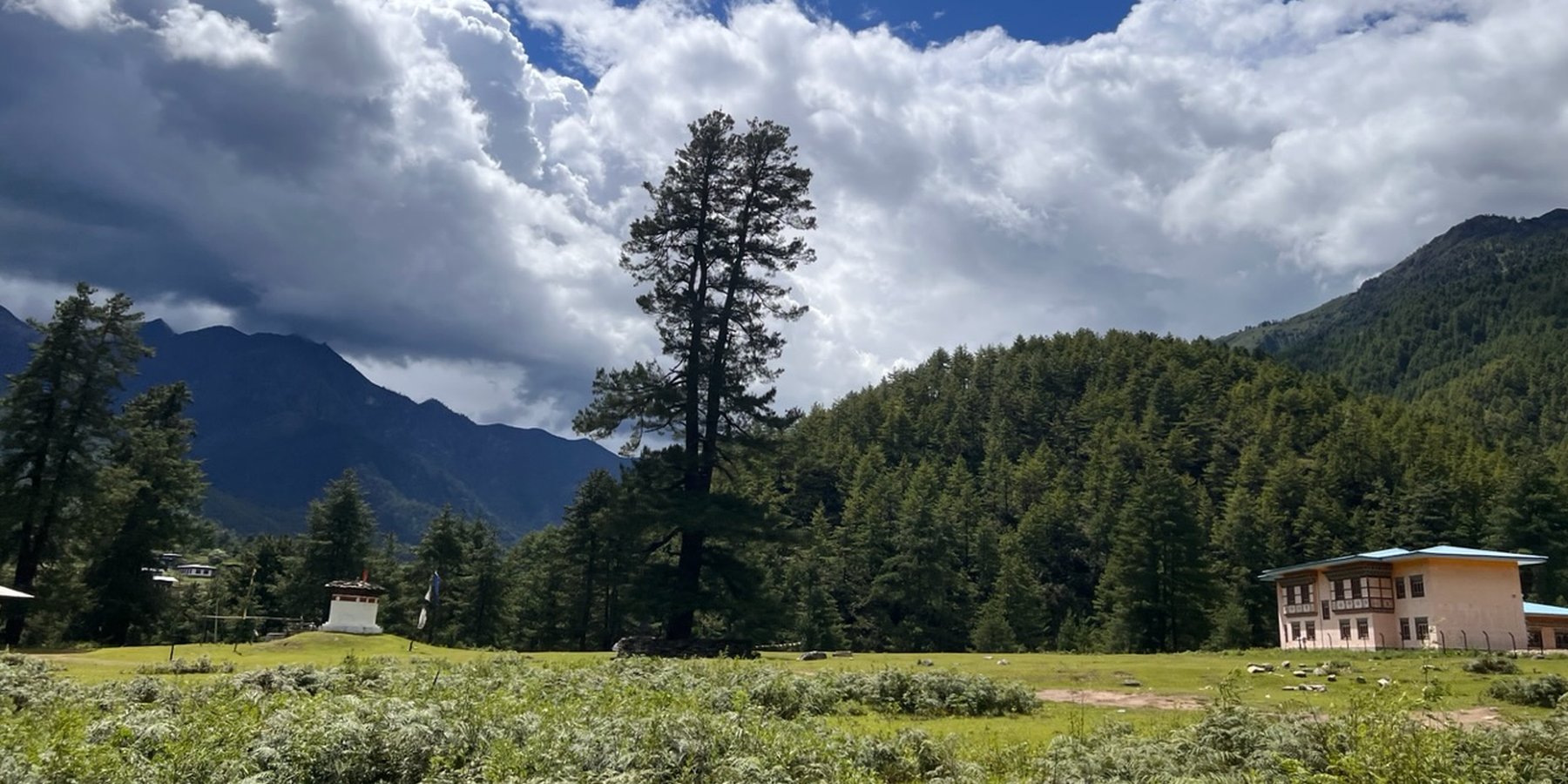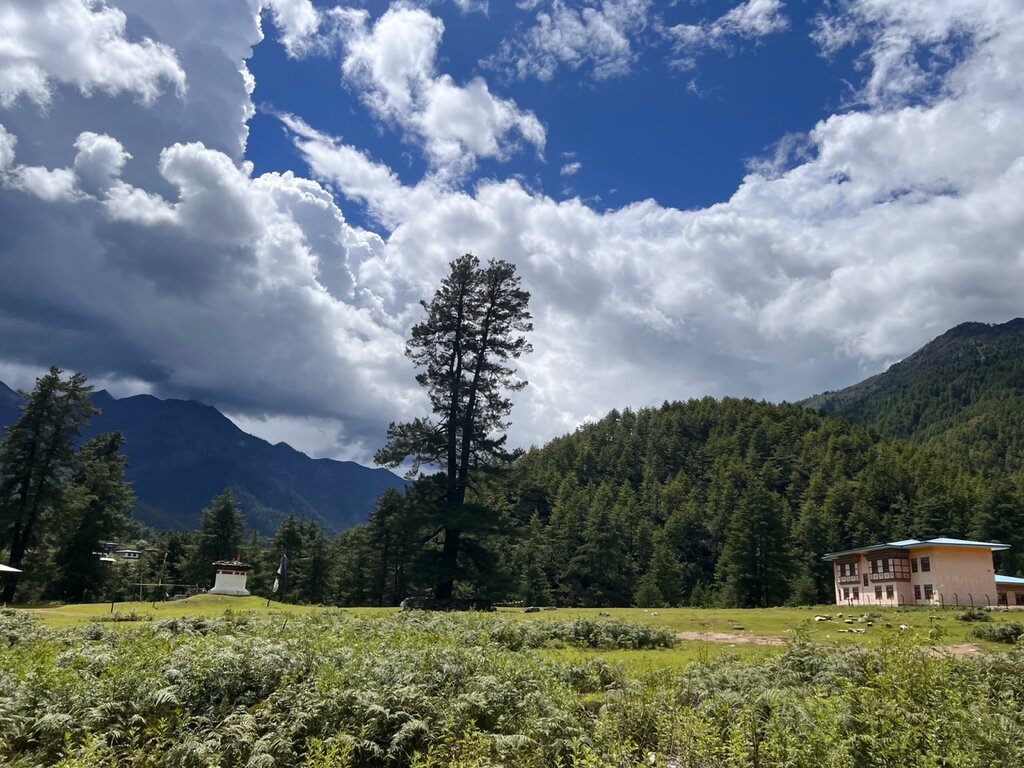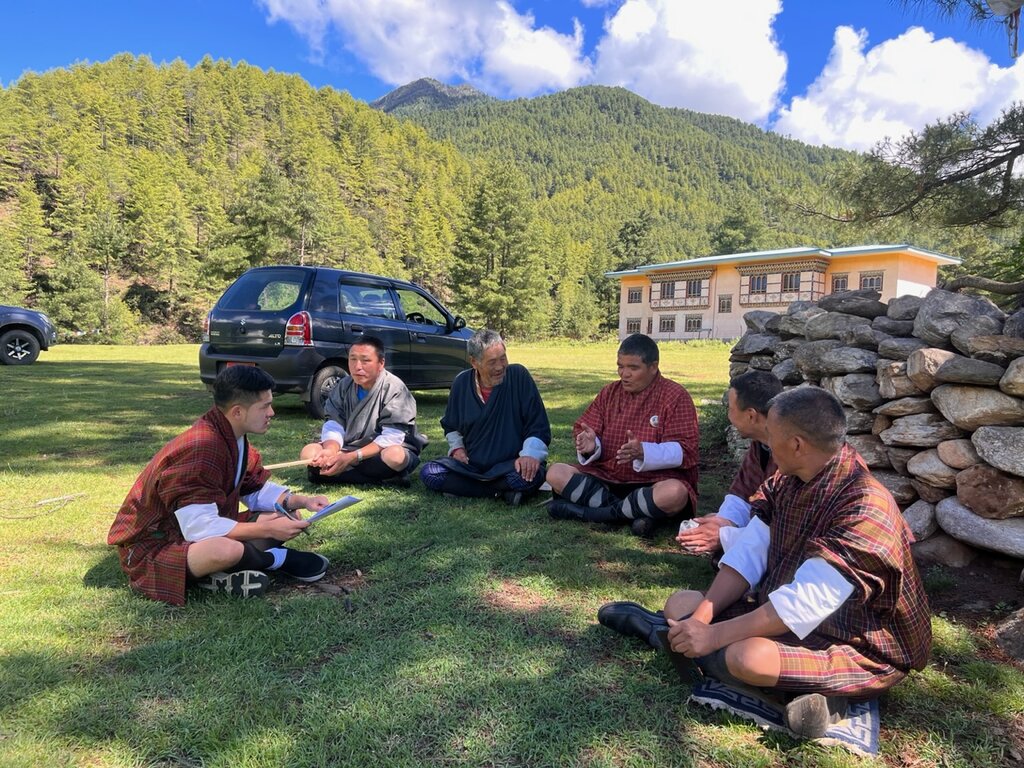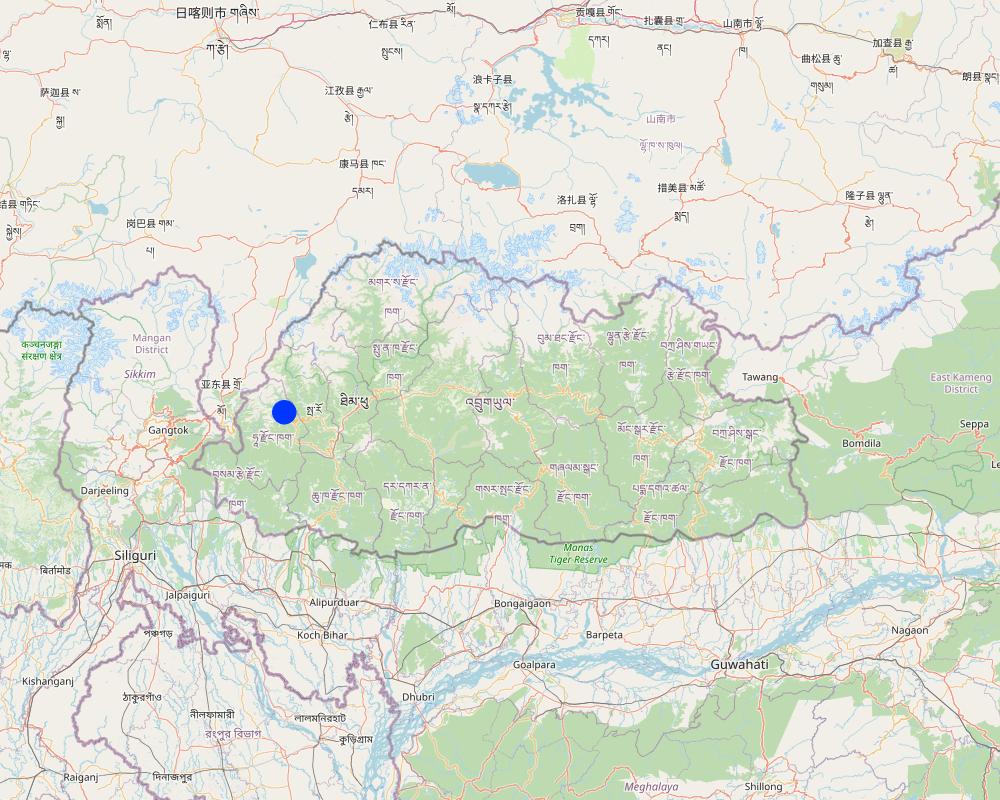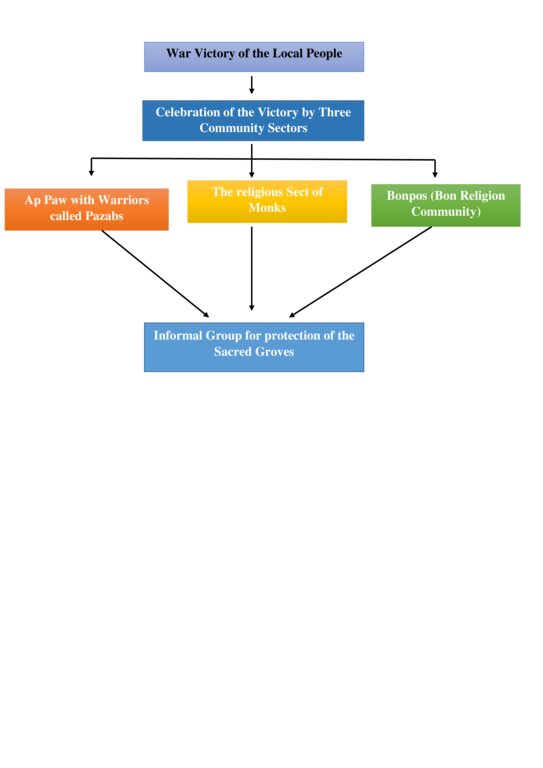Sacred Groves as Informal Protected Areas [Bhutan]
- Creation:
- Update:
- Compiler: Karma Wangdi
- Editor: Tashi Wangdi
- Reviewers: William Critchley, Rima Mekdaschi Studer
Ney dang Draktsen Tshu Sakhong Sungchop Khey Chhey Yoep (གནས་དང་བྲག་བཙན་ཚུ་ས་ཁོངས་སྲུང་སྐྱོབ་ཁྱད་ཆོད་ཡོདཔ།)
approaches_6856 - Bhutan
View sections
Expand all Collapse all1. General information
1.2 Contact details of resource persons and institutions involved in the assessment and documentation of the Approach
Key resource person(s)
land user:
Penjor Tashi
+97577370208
penjortashi73@gmail.com
Land user
Talung Chhiwog. Bji Geog Haa Dzongkhag
Bhutan
land user:
Kachey Kachey
+97517653226 / +97577212528
Land user
Talung Chhiwog Bji Geog Haa Dzongkhag
Bhutan
land user:
Passang Passang
+97517740196
Land user
Talung Chhiwog Bji Geog Haa Dzongkhag
Bhutan
land user:
Norbu Kezang
+97517444777
Land user
Yangthang Chhiwog Bji Geog Haa Dzongkhag
Bhutan
land user:
Tshentse Tshentse
+97517842997
Land user
Yangthang Chhiwog Bji Geog Haa Dzongkhag
Bhutan
Name of the institution(s) which facilitated the documentation/ evaluation of the Approach (if relevant)
National Soil Services Center, Department of Agric (National Soil Services Center, Department of Agric) - Bhutan1.3 Conditions regarding the use of data documented through WOCAT
When were the data compiled (in the field)?
15/07/2023
The compiler and key resource person(s) accept the conditions regarding the use of data documented through WOCAT:
Yes
2. Description of the SLM Approach
2.1 Short description of the Approach
A sacred grove is considered to be the home of the Local Deity of a region and is revered and protected by the people with respect and dedication. Here, a sacred grove of trees and undisturbed ground surround a majestic blue pine that is believed to be more than 350 years old.
2.2 Detailed description of the Approach
Detailed description of the Approach:
A sacred grove is considered to be the home of the Local Deity of a region and is revered and protected by the people with respect and dedication. Here, a sacred grove of trees and undisturbed ground surround a majestic blue pine that is believed to be more than 350 years old.
The distinct feature of the approach is that it is undertaken by an informal group borne out of pure faith and dedication to their local hero and legend. In this case, people protect and conserve a particular sanctuary the size of two football pitches. Trees surround it with important signs and symptoms considered to serve the purpose of sacred offerings to the deity that saved the people of that locality in the 17th century AD.
In the middle is a tall blue pine tree that holds a prayer flag on its crown which is renewed once a year. It is believed to have been planted some 350 years ago to mark the victory of the people of Haa against Tibetan invaders. The victory of the Haaps was guaranteed by the magic and Herculaneum feat of Ap Chhundue who is said to have defeated every Tibetan soldier with a single slash in that very ground.
To revere him for his extraordinary deeds, people celebrate two types of occasions, decorating the surrounding trees and encircling the middle tree singing and citing words of praise to Ap Chhundue while holding a sword in one hand and a circular shield in another. The village's Pawo (oracle) performs his rituals, foretells the general predictions and warnings (if any) for the coming year, and suggests remedies and tips for a fruitful year ahead.
During the occasion, the trees that grow around are tied with colourful prayer flags and scarves. Different shapes and sizes of ritual cakes are made and kept in front of the sacred tree and a set of prayers is conducted by the monks led by the head lama of Haa Rabdey (monastic school). The sacred tree in the middle and other trees are included among the ritual cakes and have to be equally mentioned in the prayers that the monks recite. That is why these trees are left untouched.
As per the grandson of their former Ap Pawo (Astrologer/ Oracle) who never missed the events happening in that haven, he saw a connection and coexistence of three different backgrounds with one goal in mind, which was to preserve that sacred place and continue to pass it on to future generations.
In conclusion, the people of Haa not only preserve their culture and identity, but also preserve and promote the natural environment. No wonder Haa Dzongkhag (State) is still under 80% forest cover - contributing to a carbon-negative nation.
2.3 Photos of the Approach
General remarks regarding photos:
The photo was taken during the documentation in the middle of the ground surrounded by sacred groves.
2.4 Videos of the Approach
Comments, short description:
n/a
2.5 Country/ region/ locations where the Approach has been applied
Country:
Bhutan
Region/ State/ Province:
Haa
Further specification of location:
Jangkakha, Bji Geog
Comments:
Exact spot where the sacred groves are is spotted and marked. The one we have documented is the most popular one in our country for which we can get data and the right information.
Map
×2.6 Dates of initiation and termination of the Approach
If precise year is not known, indicate approximate date when the Approach was initiated:
more than 50 years ago (traditional)
Comments:
Indeed more that 350 years has passed after the initiative.
2.7 Type of Approach
- traditional/ indigenous
2.8 Main aims/ objectives of the Approach
The main aims/objectives of the approach are:
1) Maintaining the sanctity and sacredness of the place.
2) Protect sacred trees believed to hold important historical imprints.
3) Promote and preserve cultural and historical significance of the place through worship of the sacred trees and rocks in the place.
4) Strengthen and improve coordination and cooperation among different villages of the region.
2.9 Conditions enabling or hindering implementation of the Technology/ Technologies applied under the Approach
social/ cultural/ religious norms and values
- enabling
Preserves the social cohesion and traditional values of Haa valley.
- hindering
Difficult to organize due to the dwindling rural population.
availability/ access to financial resources and services
- enabling
The local people celebrate two significant religions ceremonies in that place.
collaboration/ coordination of actors
- enabling
During religious ceremonies and offerings, people of different villages of the region come together to celebrate and worship the same hero (Guardian Deity)
3. Participation and roles of stakeholders involved
3.1 Stakeholders involved in the Approach and their roles
- local land users/ local communities
Indeed every people of the locality are involved especially the village representatives called Gup( Sub-district head) and other local leaders of different communities.
Their role is to protect the place from external destruction by foreign investors and wood industries.
- community-based organizations
Lead by the community representatives, they honor and even celebrate and worship the trees in and around the celebration ground.
- teachers/ school children/ students
Teachers lead students in bush cleaning and mass paper picking every 3 months and after big celebrations.
- local government
Local government plays crucial role in organizing two important occasions where people of the community come together to celebrate and worship these sacred groves of trees.
3.2 Involvement of local land users/ local communities in the different phases of the Approach
| Involvement of local land users/ local communities | Specify who was involved and describe activities | |
|---|---|---|
| initiation/ motivation | self-mobilization | It all started in the 17th Century after local people decided to make offer and worship the sacred battle ground. |
| planning | self-mobilization | No other people or policy makers were involved in planning. |
| implementation | The local people implemented this approach of protection and preservation of the natural environment | |
| monitoring/ evaluation | none | |
| none |
3.3 Flow chart (if available)
Description:
General history/ flow chart of the informal group Approach.
Author:
Tshering Gyeltshen.
3.4 Decision-making on the selection of SLM Technology/ Technologies
Specify who decided on the selection of the Technology/ Technologies to be implemented:
- land users alone (self-initiative)
Explain:
The approach is a non-formal self initiated cultural practice that is being passed down from forefathers to younger generation.
Specify on what basis decisions were made:
- personal experience and opinions (undocumented)
4. Technical support, capacity building, and knowledge management
4.1 Capacity building/ training
Was training provided to land users/ other stakeholders?
No
4.2 Advisory service
Do land users have access to an advisory service?
No
4.3 Institution strengthening (organizational development)
Have institutions been established or strengthened through the Approach?
- yes, a little
Specify the level(s) at which institutions have been strengthened or established:
- regional
Describe institution, roles and responsibilities, members, etc.
This approach brings together different sectors of Haa Dzongkhag to celebrate amd honour the local deity of Haa on the ground where sacred groves of forest is protected.
4.4 Monitoring and evaluation
Is monitoring and evaluation part of the Approach?
No
4.5 Research
Was research part of the Approach?
No
5. Financing and external material support
5.1 Annual budget for the SLM component of the Approach
If precise annual budget is not known, indicate range:
- < 2,000
Comments (e.g. main sources of funding/ major donors):
The main donor for the preservation of culture to conserve the Nature through protecting the area is Culture sector of the Dzongkhag Administration.
5.2 Financial/ material support provided to land users
Did land users receive financial/ material support for implementing the Technology/ Technologies?
No
5.3 Subsidies for specific inputs (including labour)
- none
If labour by land users was a substantial input, was it:
- voluntary
5.4 Credit
Was credit provided under the Approach for SLM activities?
No
5.5 Other incentives or instruments
Were other incentives or instruments used to promote implementation of SLM Technologies?
No
6. Impact analysis and concluding statements
6.1 Impacts of the Approach
Indeed the approach is a consistent cooperative commitment of the lo at land users.
Did the Approach enable evidence-based decision-making?
- No
- Yes, little
- Yes, moderately
- Yes, greatly
Yes, there are incidences of people going against the belief and rule of the approach that they faced consequences in the form of mishaps and trouble.
Did the Approach help land users to implement and maintain SLM Technologies?
- No
- Yes, little
- Yes, moderately
- Yes, greatly
This approach directly leads to natural preservation and promotion of Sustainable Land Management.
Did the Approach build/ strengthen institutions, collaboration between stakeholders?
- No
- Yes, little
- Yes, moderately
- Yes, greatly
This approach leads to strengthening of the collaboration and cooperation among communities especially during one of the celebrations of their local deity where trees are also worshiped and appreciated.
Did the Approach mitigate conflicts?
- No
- Yes, little
- Yes, moderately
- Yes, greatly
There’s no direct climate mitigation but in a way fights global warming through prevention of deforestation.
Did the Approach lead to more sustainable use/ sources of energy?
- No
- Yes, little
- Yes, moderately
- Yes, greatly
The idea of the approach is that people can collect dead and dry branches of wood from the sacred groves. The land users could also collect dry pine leaves but should not cut down the trees or surrounding young pants. So definitely the approach encourages sustainable use of resources.
Did the Approach improve the capacity of the land users to adapt to climate changes/ extremes and mitigate climate related disasters?
- No
- Yes, little
- Yes, moderately
- Yes, greatly
Did the Approach lead to employment, income opportunities?
- No
- Yes, little
- Yes, moderately
- Yes, greatly
It is an informal group/ approach where no one is recruited.
6.2 Main motivation of land users to implement SLM
- increased production
- reduced land degradation
Proper growth and establishment of the natural habitat definitely reduced land degradation.
- reduced risk of disasters
Disaster such as soil erosions are reduced.
- prestige, social pressure/ social cohesion
Social cohesion and cooperation promoted
- customs and beliefs, morals
This approach entirely rests upon customs and beliefs.
6.3 Sustainability of Approach activities
Can the land users sustain what has been implemented through the Approach (without external support)?
- yes
If yes, describe how:
This approach of protected area has been passed down for generations dating back to 17th century and with strong and undying belief, it will sustain without external support.
6.4 Strengths/ advantages of the Approach
| Strengths/ advantages/ opportunities in the land user’s view |
|---|
| Preservation and promotion of culture and traditions |
| Paying tribute and respects, which ultimately leads to blessings and protection ensured by their local deity. |
| Prevention of uncontrollable calamities and disasters. |
| Strengths/ advantages/ opportunities in the compiler’s or other key resource person’s view |
|---|
| Improvement of unity and cooperation among and within local communities. |
| Unique culture and custom which provides unique identity to the local people. |
| Intense respect, connection and harmony with nature and unseen forces. |
6.5 Weaknesses/ disadvantages of the Approach and ways of overcoming them
| Weaknesses/ disadvantages/ risks in the land user’s view | How can they be overcome? |
|---|---|
| Lack of belief and interest in such beliefs by younger generation. | Parents must retell the legendary history and restore faith in young minds. |
| Diminishing of the faith and customs passed down from forefathers. | Spark faith and interest through stories and proofs. |
| Lack of cooperation among and within local communities. | Must make it a formal group in future. |
| Weaknesses/ disadvantages/ risks in the compiler’s or other key resource person’s view | How can they be overcome? |
|---|---|
| Lack of written accounts and documents. | Must start drafting general charter of the informal group. |
| Lack of proper hierarchy and coordination of events related to the approach. | Must have a formal association. |
| Lack of funds and budget for general coordination and celebrations during the workshop of the sacred grooves. | Provide funds for continued preservation of the natural habitat of the place. |
7. References and links
7.1 Methods/ sources of information
- field visits, field surveys
5 informants
- interviews with land users
5 people were interviewed.
7.2 References to available publications
Title, author, year, ISBN:
n/a
Available from where? Costs?
n/a
7.3 Links to relevant information which is available online
Title/ description:
n/a
URL:
n/a
Links and modules
Expand all Collapse allLinks
No links
Modules
No modules


